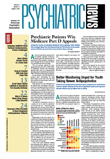Conducting alcohol counseling sessions with the elderly in primary care settings is as effective at reducing alcohol consumption for at-risk drinkers as referring them to a mental health or substance abuse specialist in the community.
This is what researchers found in the Primary Care Research in Substance Abuse and Mental Health for the Elderly (PRISM-E) study, though the authors noted a number of limitations to the study.
The goal of the study was to assess whether and to what extent two models of care improved access to services, cost of services, and mental health outcomes.
In the process, the study highlighted important problems with access to and provision of care, even when common barriers to mental health services were removed. The findings are reported in the July Psychiatric Services.
Researchers at nine primary care sites screened patients aged 65 and older for participation in the study between March 2000 and March 2002.
Patients were considered eligible if they exhibited at-risk drinking, which was defined as drinking more than 14 drinks per week for men, more than 12 drinks per week for women, or four or more drinks four or more times during the prior three months for either men or women.
Researchers assessed 560 subjects at baseline and at three and six months in face-to-face or telephone interviews.
They measured the amount and frequency of alcohol use seven days before each assessment and the number of binge-drinking episodes before each assessment.
Two groups of 280 subjects each were randomly assigned to receive treatment in an integrated-care model or an enhanced specialty referral model. Staff at each primary care site or mental health or substance abuse clinic were responsible for developing treatment plans and initiating care.
Clinicians working under the integrated-care condition received a half day of training on administering face-to-face alcohol intervention counseling sessions, which included discussions with patients on drinking cues, reasons for drinking, and reasons to cut down or quit, among other issues.
Those randomized to the integrated-care model were to receive three 20- to 30-minute counseling sessions.
In addition, participants with at-risk drinking and comorbid mental health disorders were treated for both simultaneously.
According to lead author David Oslin, M.D., an associate professor of psychiatry at the University of Pennsylvania, those randomized to receive specialty care referrals had no copays, transportation was provided to appointments, and when patients did not show up to an appointment, the specialist (usually a psychiatrist or psychologist) was instructed to call the patient to try to engage him or her in treatment. In this referral model, each clinician decided what treatment was most appropriate for each patient.
Not `Real-World' Conditions
“These are all things that don't typically happen in the real world,” Oslin told Psychiatric News.
However, many participants did not receive the services assigned to each group for various reasons.
For instance, only 65 percent of participants assigned to the integrated-care model had at least one face-to-face visit with the primary care provider, and just 38 percent assigned to the referral group sat down at least once with the mental health or substance abuse clinician to whom they were referred.
In the integrated-care model, only 120 participants (43 percent) received at least one brief alcohol intervention session after the study began, and only 24 patients (9 percent) had the recommended three brief alcohol intervention sessions.
On average, fewer participants in the integrated-care model who had a mental disorder received an alcohol counseling session (23 patients) than did those without such a disorder.
Oslin found that at baseline, participants consumed a mean of 17.9 drinks per week and had a mean of 21.1 binge episodes in the prior three months.
Consumption Declined
After six months, the quantity of alcohol consumed among participants in both models declined by 35 percent. Frequency of drinking and binge drinking declined under both models by 45 percent.
The reductions in drinking reinforce the importance of identifying and treating older people with alcohol use, the authors pointed out.
However, there were no significant differences in drinking measures between the models by the end of the study.
Oslin acknowledged that since there was no control group in the study, it is impossible to determine whether the reductions in drinking were due to the services they received during the intervention.
Drinking reductions could have come about for other reasons, he noted.
“By participating in this trial, subjects were getting a fair amount of assessment and were made to be aware of their health behaviors,” Oslin said. “For some, this awareness may have changed their behavior.”
The authors noted that perhaps the most important finding was the low engagement rate of study participants in each group's intervention. They attributed some of the lack of participation to the fact that “the study conducted screening with non-treatment-seeking patients” and also that while all participants engaged in risky drinking behavior, only 55 percent could be classified as having an alcohol use disorder.
Also, there were problems with fidelity to study protocol on the part of clinicians in the primary care clinics, Oslin noted.
“Training [on alcohol counseling sessions] was limited to a four-hour session, and almost all of the providers trained had no prior experience with delivering brief alcohol interventions,” the authors wrote.
Also, there was no formal feedback on delivery of the model and no ongoing supervision, according to the report.
Oslin said future research should examine ways to improve treatment participation by people who engage in risky drinking behaviors.
The PRISM-E study was funded by the Substance Abuse and Mental Health Services Administration. The Department of Veterans Affairs, the Health Resources and Services Administration, and the Centers for Medicare and Medicaid Services provided additional support and funding.
